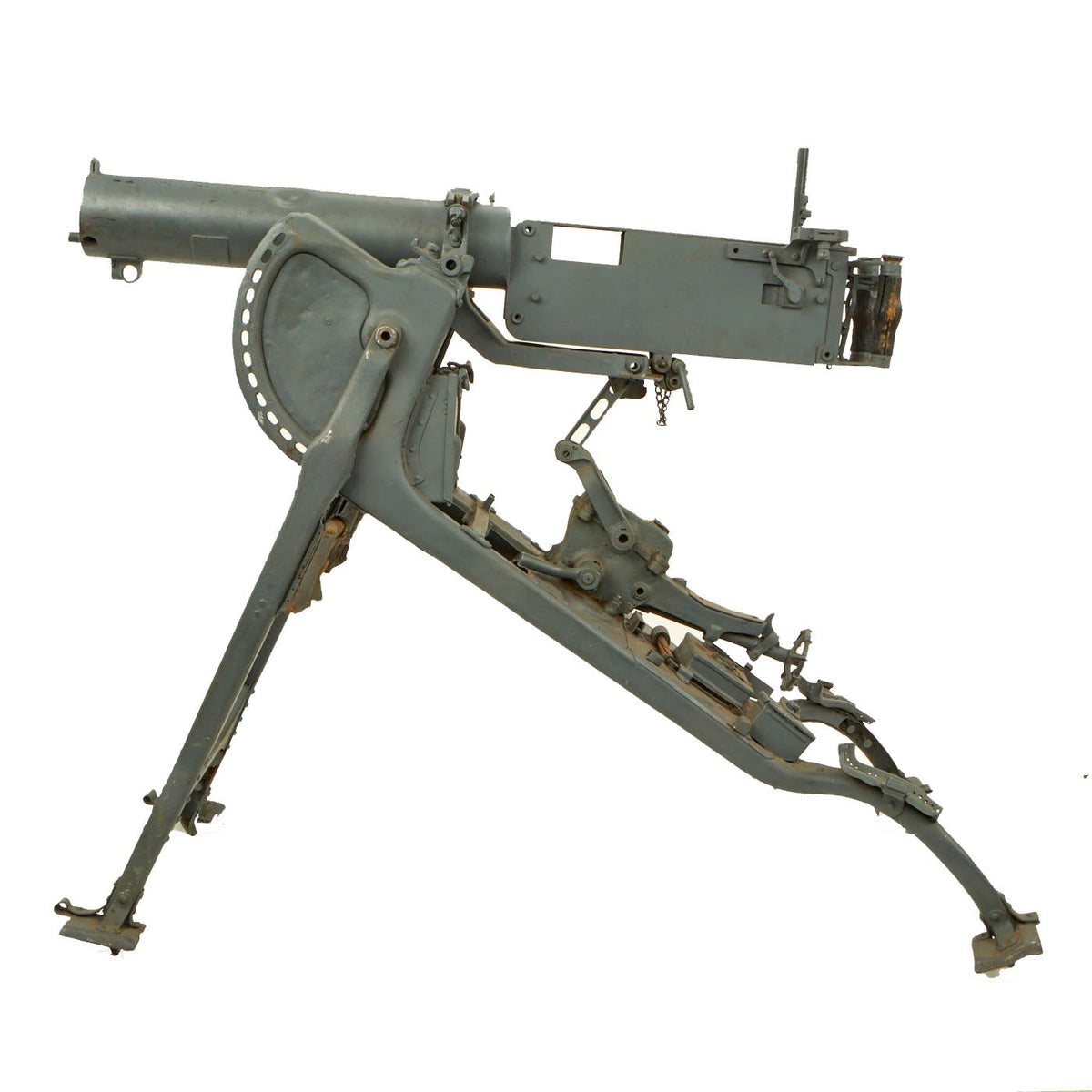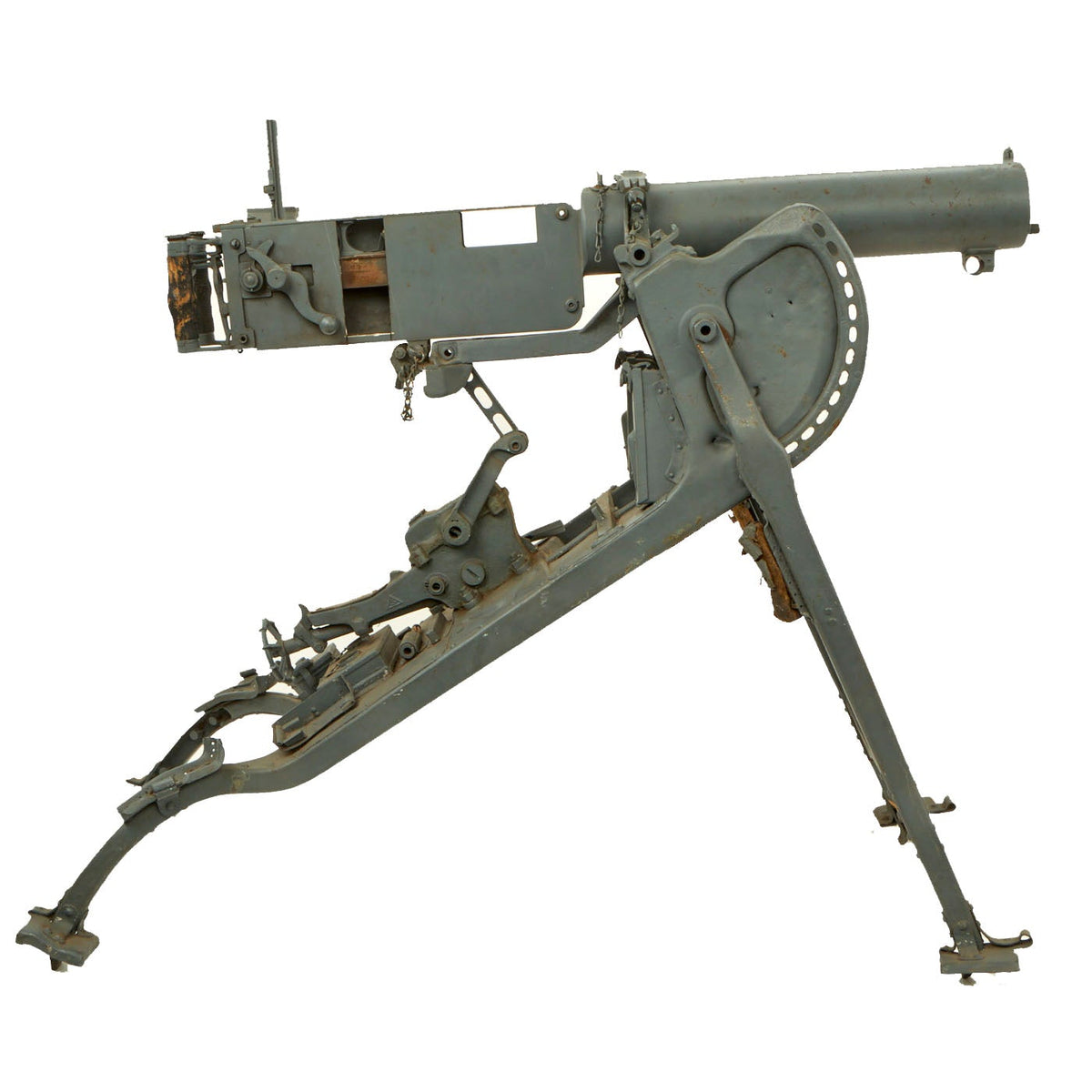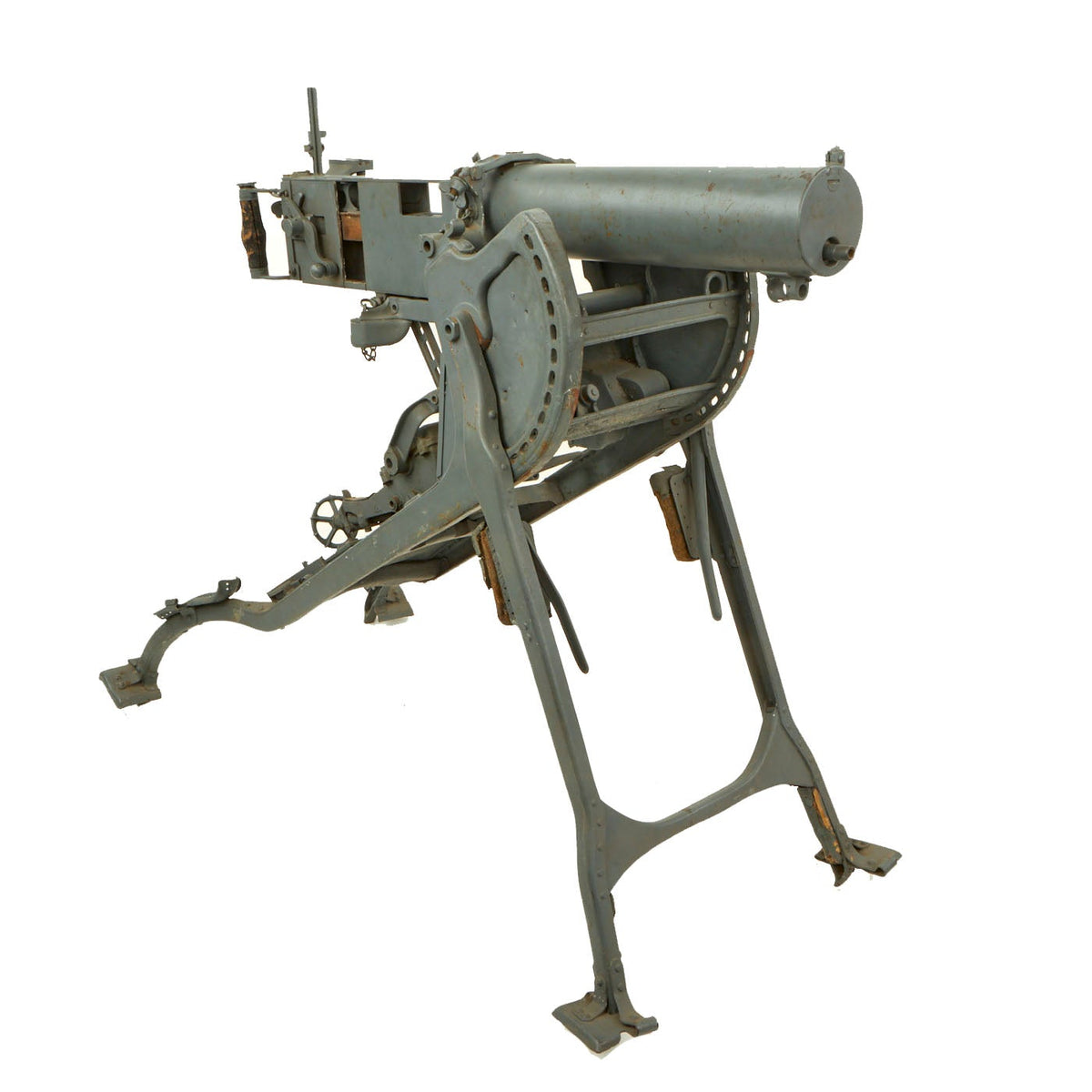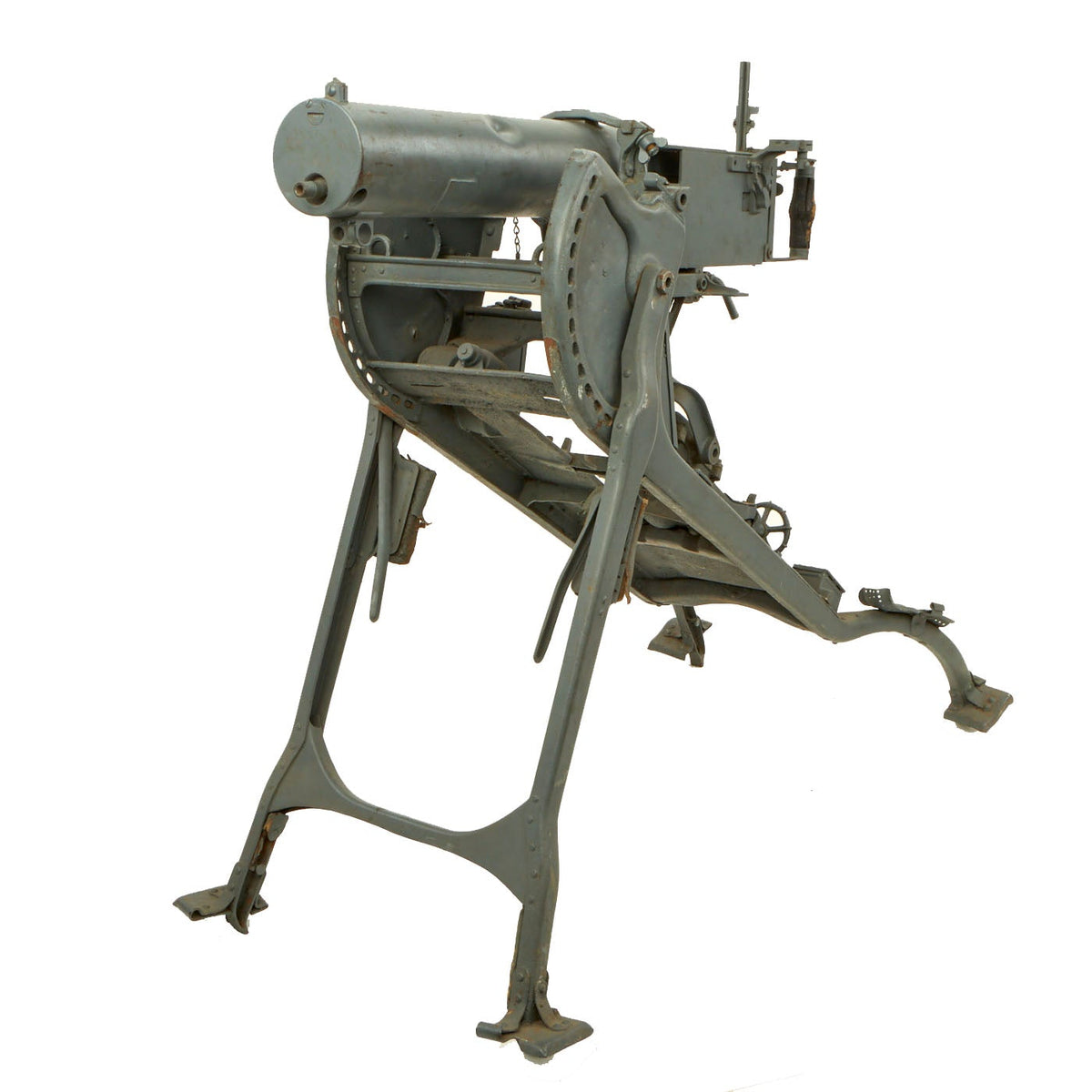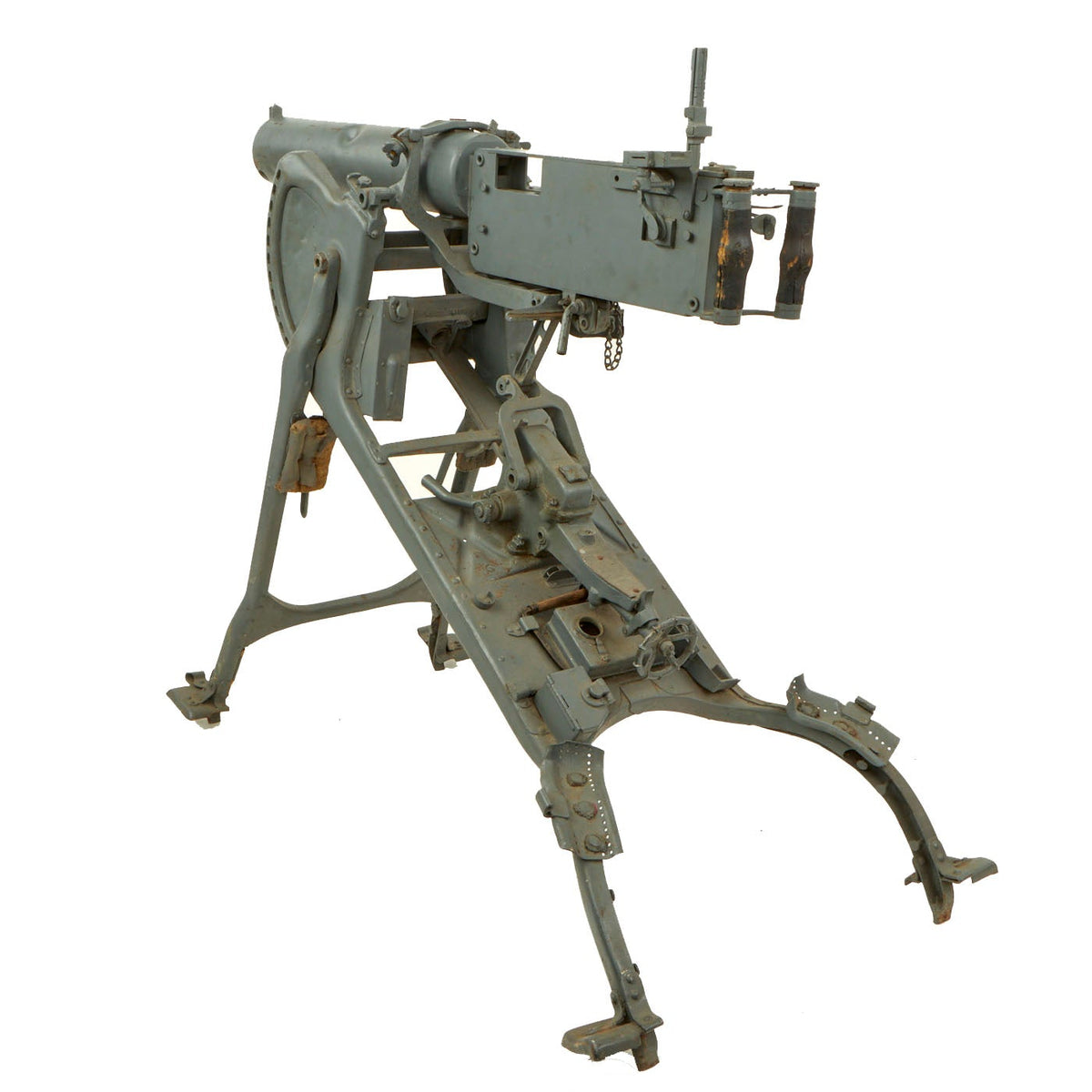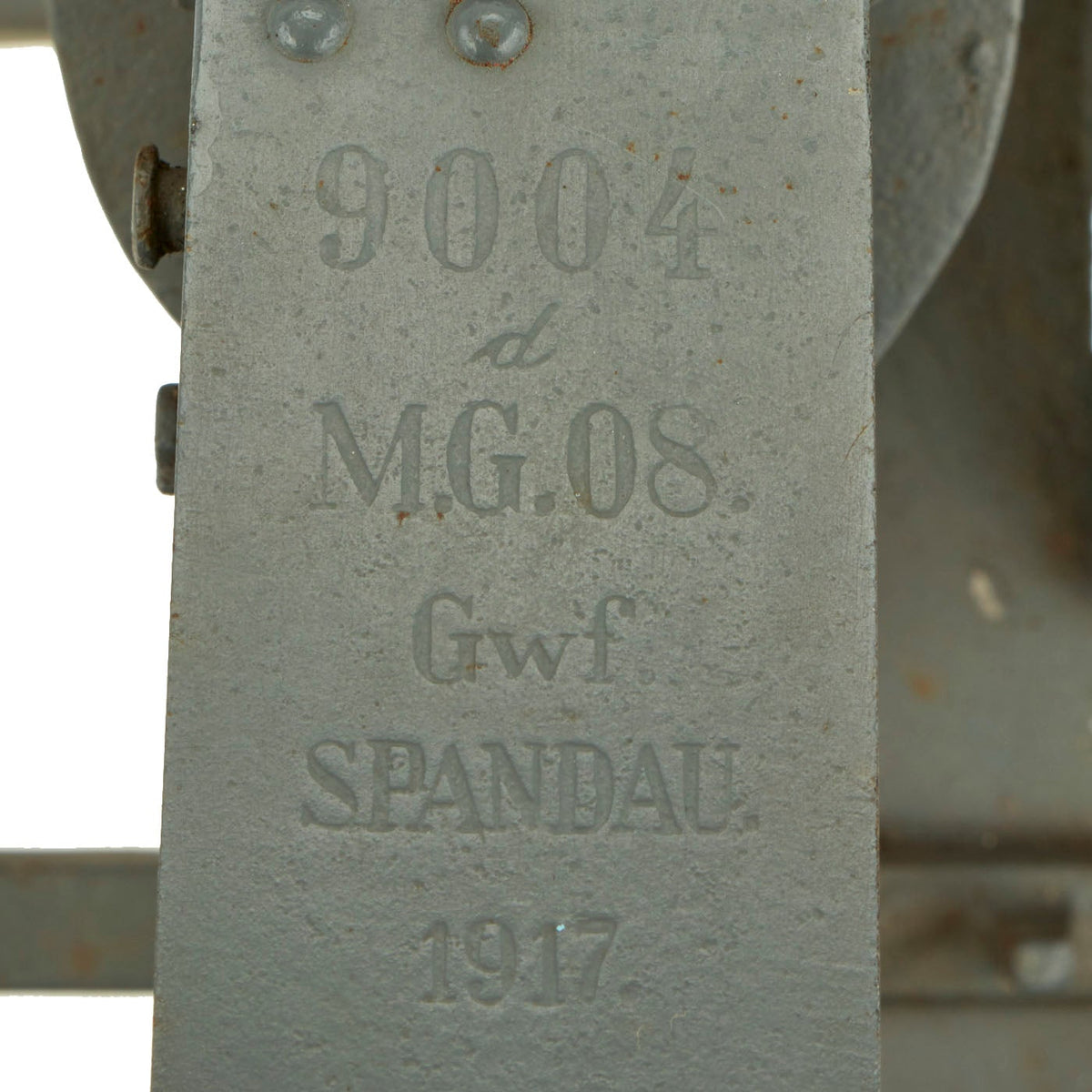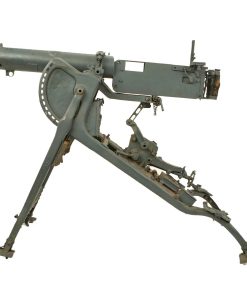Original German WWI Maxim MG 08 Display Gun by Spandau dated 1917 with Sled Mount dated 1918 Original Items
$ 9.995,00 $ 2.498,75
Original Item: One of a kind. Opportunities like this do not come along very often at all, and this may in fact be a once in a lifetime opportunity. MG08 Machine guns on original sled mounts are nearly impossible to find on the market, and this pair has been together probably since the first world war. The U.S. Navy Style “Haze Blue” paint job on the gun and mount tell us that most likely this was used as a V.F.W. “Gatekeeper” ornament, kept just inside the front door. Obsolete captured armaments from the foreign wars were often distributed to Veteran’s organizations following WWII. The very durable paint job has really kept it well preserved! This genuine German WW1 MG 08 water-cooled Maxim machine gun was “The Grim Reaper” of the First World War.
The display gun included in this lovely set is totally inert, having had the right side plate demilitarized to BATF specifications to make it a totally legal non-firing display gun. The lock was removed, and the chamber of the barrel welded up as part of the demilitarization process. The overall condition of the gun is very good, though as with most guns left out for display, the wooden grips have suffered, now quite deteriorated and delicate.
The top is nicely marked:
9004
d
M.G.08
Gwf.
SPANDAU.
1917.
Spandau Arsenal, known in German as Gewehr und Munitionsfabrik (Gwf.) Spandau during the WWI period, the center for development of military small arms for Imperial Germany from the Industrial Revolution until 1919. They manufactured many long arms during the 19th and early 20th centuries at the their location, which is today part of Berlin.
The top cover is marked with serial number 9004/d, which matches the serial number on the spade grips, barrel jacket, sight bracket, and just about all of the other parts that it is still visible on. Most likely this Maxim never had any parts swapped out other than the barrels and locks, which had to be done periodically. There are lot of markings and proofs on this example, typical of WWI German production.
As with most Maxim guns on display for a long time, unfortunately a lot of the external components have been removed for transit or storage, and were never returned to the gun. The muzzle gland and all of the attachments are missing, as is the fusee spring and cover. The paint and the elements have also frozen up the crank and entire action, however this does nothing to interfere with the display potential. This really looks the business, and is just great.
The included sled mount (Schlittenlafette or “Sled Carriage”) is all original except for the paint, and is really a good example, still solid without any rusting. As we usually see, the leather and horsehair padding for the knee rests are almost completely gone. The pads on the front legs however are still relatively well preserved, protected from the elements more than the rear. The elevation control works, and the elevation release works as well, which allowed the elevation to be set without the fine control. Most of the smaller pieces have unfortunately been removed or broken off over the years, such as the caps for the solvent and oil can and the lock for the spare barrel holder. However, both lock boxes are intact and functional, and there is even a well weathered angular cleaning tool present. The sled mount legs can adjust and fold up as designed.
The mount is dated 1918 on the left front side, while serial number 9604 is marked on the right side. There also is what may be a partial maker or unit marking next to the serial number: ÜRKORP. Definitely some great markings worth of further investigation!
It has been over 100 years since of the conclusion of WWI. A terrible conflict that lasted 4 tortuous years and destroyed the manhood of Europe. It only concluded after the entry of the United States in 1917 to tip the scales to the Allies favor ending at the 11th hour on the 11th day of the 11th month in 1918.
With a 1917 date, this gun and most likely the mount were almost certainly used in the conflict. Ready to be the crown jewel of your WWI Collection!
History of the MG 08-
The Maschinengewehr 08, or MG 08, was the German Army’s standard machine gun in World War I and is an adaption of Hiram S. Maxim’s original 1884 Maxim gun. It was produced in a number of variants during the war. The MG 08 served during World War II as a heavy machine gun in many German infantry divisions, although by the end of the war it had mostly been relegated to second-rate fortress units.
The Maschinengewehr 08 (or MG 08)- so-named after 1908, its year of adoption – was a development of the license made Maschinengewehr 01. It could reach a firing rate of up to 400 rounds per minute using 250-round fabric belts of 7.92x57mm ammunition, although sustained firing would lead to overheating; it was water-cooled using a jacket around the barrel that held approximately one gallon of water. Using a separate attachment sight with range calculator for indirect fire, the MG 08 could be operated from cover. Additional telescopic sights were also developed and used in quantity during the war.
The MG 08, like the Maxim gun, operated on the basis of short barrel recoil and a toggle lock; once cocked and fired the MG 08 would continue firing rounds until the trigger was released (or until all available ammunition was expended). Its practical range was estimated at some 2,000 metres (2,200 yd) up to an extreme range of 3,600 metres (3,900 yd). The MG 08 was mounted on a sled mount (German: Schlittenlafette) that was ferried between locations either on carts or else carried above men’s shoulders in the manner of a stretcher.
Pre-war production was by Deutsche Waffen und Munitionsfabriken (DWM) in Berlin and the government arsenal at Spandau (so that the gun was often referred to as a Spandau MG 08).
Fast Shipping with Professional Packaging
Thanks to our longstanding association with UPS FedEx DHL, and other major international carriers, we are able to provide a range of shipping options. Our warehouse staff is expertly trained and will wrap your products according to our exact and precise specifications. Prior to shipping, your goods will be thoroughly examined and securely secured. We ship to thousands clients each day across multiple countries. This shows how we're dedicated to be the largest retailer on the internet. Warehouses and distribution centres can be located throughout Europe as well as the USA.
Note: Orders with more than one item will be assigned a processing date depending on the item.
Before shipping before shipping, we'll conduct a thorough inspection of the items you have ordered. Today, the majority of orders will be delivered within 48 hours. The delivery time will be between 3-7 days.
Returns
The stock is dynamic and we cannot completely manage it because multiple stakeholders are involved, including our factory and warehouse. So the actual stock may alter at any time. It's possible that you may not receive your order once the order has been made.
Our policy is valid for a period of 30 days. If you don't receive the product within 30 days, we are not able to issue a refund or an exchange.
You can only return an item if it is unused and in the same state as the day you received it. You must have the item in its original packaging.
Related products
Uncategorized
Armoured Fighting Vehicles of the World: AFVs of World War One (Hardcover Book) New Made Items
Uncategorized
Uncategorized
Uncategorized
Uncategorized
Australian WWII Owen MK1 Machine Carbine SMG Custom Fabricated Replica with Sling Original Items
Uncategorized
Armored Burgonet Helmet & Polearm from Scottish Castle Leith Hall Circa 1700 Original Items
Uncategorized
Uncategorized
Uncategorized
Uncategorized
Uncategorized
Uncategorized
Uncategorized
Uncategorized
Uncategorized
Angolan Rebel 1970s era 60mm Inert Display Mortar from Angolan Civil War Original Items
Uncategorized
Uncategorized
Uncategorized
